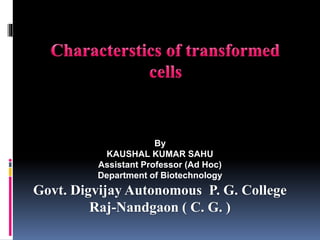
Characterstics of transformed cells
- 1. By KAUSHAL KUMAR SAHU Assistant Professor (Ad Hoc) Department of Biotechnology Govt. Digvijay Autonomous P. G. College Raj-Nandgaon ( C. G. )
- 2. SYNOPSIS INTRODUCTION HISTORY CAUSESOFTRANSFORMATION CHARACTERSTICSOFTRANSFORMEDCELLS -Genetic instability -Immortalization -Aberrant growth control -Contact inhibition - Low serum requirement -Tumorigenicity CHALLENGES APPROACHESTO UNDERSTAND MALIGNANCE PROPERTIESOF CULTUREDCELLS CONCLUSION REFERENCES
- 3. INTRODUCTION In molecular biology, transformation is the genetic alteration of a cell resulting from the direct uptake and incorporation of exogenous genetic material from its surroundings through the cell membrane. “Transformation” has a special meaning in relation to animal cells, indicating progression to a cancerous state, the process is usually called “transfection”.
- 4. Sometimes eukaryotic cells exhibit unusual and alternative growth characteristics both in culture and in vivo. Such cells are usually referred to as transformed or neoplastic cells .The transformation of some cells may be induced using viruses.
- 6. HISTORY Transformation in bacteria was first demonstrated in 1928 by the British bacteriologist Frederick Griffith. Griffith was interested in determining whether injections of heat-killed bacteria could be used to vaccinate mice against pneumonia. However, he discovered that a non-virulent strain of Streptococcus pneumoniae could be made viulent after being exposed to heat-killed virulent strains. Griffith hypothesized that some "transforming principle" from the heat- killed strain was responsible for making the harmless strain virulent. In 1944 this "transforming principle" was identified as being genetic by Oswald Avery, Colin MacLeod, and Maclyn McCarty. They isolated DNA from a virulent strain of S. pneumonia and using just this DNA were able to make a harmless strain virulent.They called this uptake and incorporation of DNA by bacteria "transformation".
- 7. CAUSESOFTRANSFORMATION Transformation of cells may occur due to any one of the following causes that ultimately result in a changed genetic material: Spontaneous. Infection with transforming virus. From gene transfection. Exposure to chemical carcinogens. Exposure to ionizing radiations.
- 8. CHARACTERSTICSOFTRANSFORMEDCELLS The general characters of transformed cells are given.They are grouped as genetic, structural, growth and neoplastic.
- 9. Transformation is associated with genetic instability, immortalization, aberrant growth control and malignancy.
- 10. Genetic Instability: In general, the cell lines in culture are prone to genetic instability. A majority of normal finite cell lines are usually genetically stable while cell lines from other species (e.g. mouse) are genetically unstable, and can get easily transformed.The continuous cell lines derived from tumors of all species are unstable.
- 11. Immortalization: The acquisition of an infinite life span by a cell is referred to as immortalization. Most of the normal cells (from different species) have a finite life span of 20-100 generations. But some cells from mouse, most of the tumor cells have infinite life span, as they go on producing continuous cell lines.
- 12. Immortalization can be done by- Controlling the finite life span of cells. By viral genes. By human fibroblast. By telomerase induction.
- 13. Aberrant Growth Control: The transformed cells and the cells from tumors, grown in culture show many aberrations with respect to growth and its control. Anchorage independence: There occur several changes on the cell surfaces of transformed cells.These include alterations in the cell surface glycoproteins and integrin’s, and loss of fibronectin. Some of the transformed cells may totally lack cell adhesion molecules (CAMs).
- 14. Contact inhibition: The transformed cells are characterized by loss of contact inhibition.This can be observed by the morphological changes in the disoriented and disorganized monolayer cells.This results in a reduced density limitation of growth, consequently leading to higher saturation density compared to normal cells.
- 15. Low serum requirement: In general, transformed cells or tumor cells have lower serum dependence than the normal cells.This is mostly due to the secretion of autocrine growth factors by the transformed cells.
- 16. Some of the growth factors produced by tumor cells are given: Colony stimulating factor (CSF). Transforming growth factor (TGFa). Interleukins 1, 2 and 3. Vasoactive intestinal peptide (VIP). Gastrin releasing peptide. It may be noted that many normal cells (fibroblasts, endothelial cells) also produce autocrine factors during active stage of cell proliferating. Hence, these factors will not be of much use to serve as markers of cell transformation.
- 17. Tumorigenicity: Cell transformation is a complex process that often results in the formation of neoplastic cells.The cell lines obtained from malignant tumors are already transformed.
- 18. CHALLENGES Such cells may undergo further transformation in the in vitro culture due to: Increased growth rate. Immortalization. Reduced anchorage dependence. For the malignant transformation of cells, several steps may be required.
- 19. Two approaches to understand malignant- associated properties of cultured cells: The cells can be cultured from malignant tumors and characterized. Viral genes or chemical carcinogens can be used to transform the untransformed cells.
- 20. CONCLUSION Transformed cells are changed from normal cells to cells with many of the properties of cancerous cells. Some of these cell lines have actually been derived from tumors or are transformed spontaneously in culture by mutations. Chemical or gamma ray treated cells can become infinite with loss of growth factors. Viral infection with SV40T antigen can insert oncogenes and lead to gene alterations. No matter how transformation occurs the result is a cell with altered functional morphological and growth characterstics.
- 21. REFERENCES Culture of animal cells – IAN FRESHNEY www.biologydiscussion.com
